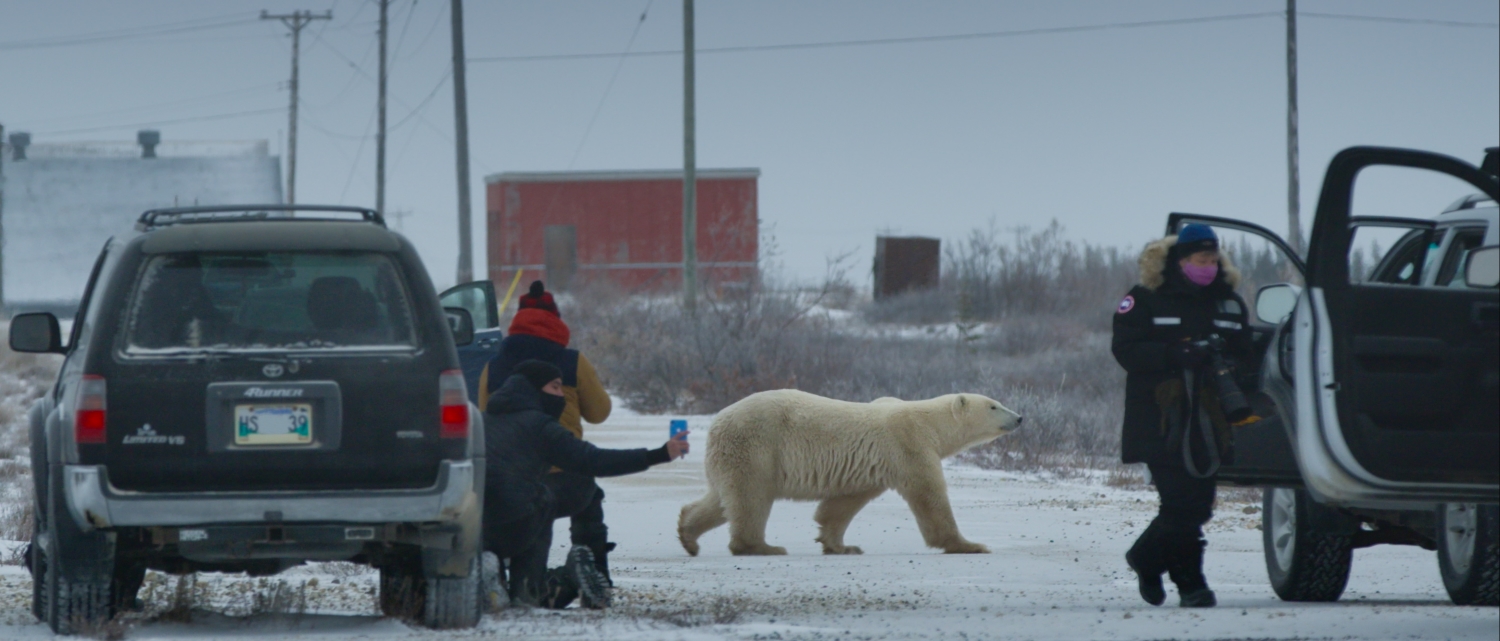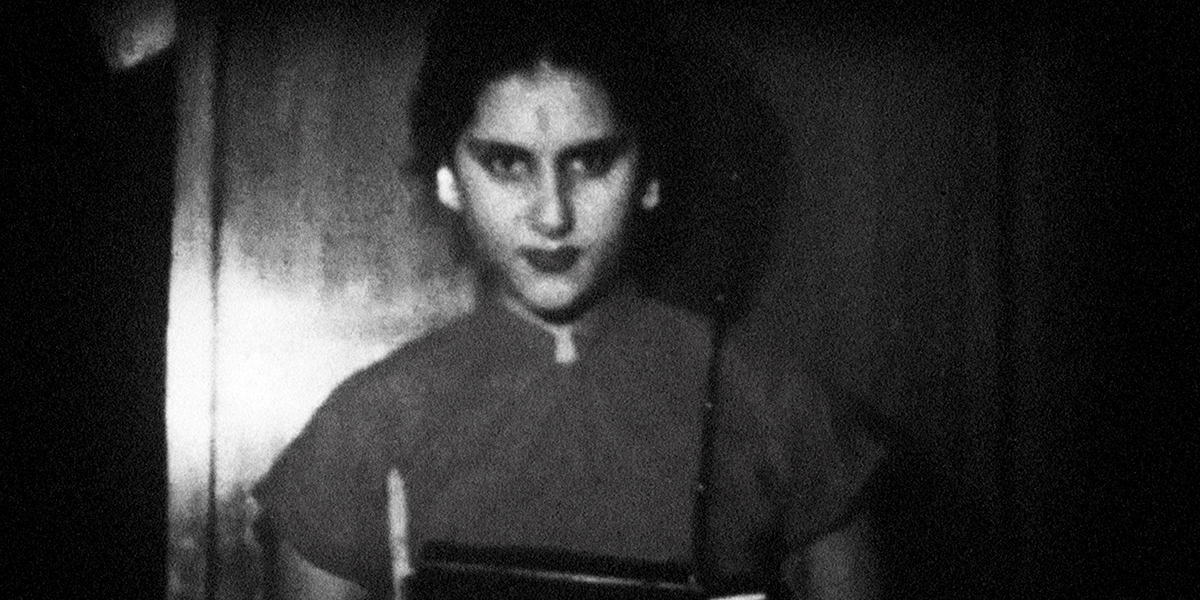If you think Kristen Stewart commands a crowd at TIFF, wait until you see the ursine stars of Nuisance Bear. This short doc by Jack Weisman and Gabriela Osio Vanden observes the polar bear migration in Churchill, Manitoba. Anyone looking for shots of momma bears nursing their cubs in the tundra, though, will be surprised. Instead, the polar bears roam the streets of the usually quiet town. Sniffing for garbage and hunting for scraps, the bears attract thousands upon thousands of gawkers annually.
“When we got to Churchill, we were shocked by the circus that pops up around the bears every fall and the stories that are being told there” says Weisman, speaking ahead of Nuisance Bear’s premiere at the Toronto International Film Festival. “It feels like the more nuanced and interesting stories are generally omitted.”
Osio Vanden says that they both grew up with a healthy appetite for nature docs, but envisioned their story as an alternative to the usual nature doc tropes—money shots of animals in the wild, and such. She echoes Weisman and says that vision came naturally as they shot off and on in Churchill since 2015. “The town’s population is normally 900 people, but during bear season, there’s around 10,000 or more tourists,” observes Osio Vanden. “On top of that, there are TV crews, photographers. It’s actually bananas—the polar bears have paparazzi.”

Polar Bears and Paparazzi
One sees this peculiar collision between the animals’ natural migration patterns and human activity in a bravura long take. The camera observes as the bear roams through the town. It passes cars, traverses a crosswalk, and puts one foot in front of the other as shutters snap. Unfazed, it’s a snapshot of a wild animal desensitized by human activity. Nuisance Bear underscores the danger that desensitization brings as the polar bear struts inches from the shutterbugs.
Weisman says that observing the polar bears for such a long period let them understand and anticipate their movements. “After a while, you learn the pattern of the bears. They have a route. They come along the coast, they smell the dump, and then they go inland to look around for the dump until they find it,” he explains. “Then they get chased away and then that pattern repeats itself.” Watching the pattern helped land the awesome long shot.
Osio Vanden adds that landing that shot was helpful in 2020, as fewer people descended upon Churchill due to the pandemic. With fewer sightseers, she explains how the bear-gazers tag-teamed in caravans and shared information. “This aspect is something that doesn’t necessarily appear in the film. But it was a part of our experience—seeing people on the road pushing each other and filling them in on what happened,” she notes. “Everybody in the town likes what’s going on, even people who aren’t filming the bears.”
Bearing Witness
Nuisance Bear isn’t so much about observing the bears as it is about observing the observers. The film’s uniquely cinematic gaze draws from Weisman and Osio Vanden’s backgrounds as cinematographers. (The doc is their directorial debut.) Nuisance Bear considers the ways in which observers use the power of the gaze. As the filmmakers’ tour the streets of Churchill, they bear witness to hordes of selfie-snapping onlookers. Tourists are eager to land one perfect shot that positions the bear in the wild even though its steps away from vehicular traffic. For viewers who’ve ever been to the Louvre, the flurry of activity around the polar bears evokes the mob of self-snapping tourists circling the Mona Lisa. The action around the rare beast speaks volumes about human behaviour.
“There’s a moment in that long clip when one tourist is taking a selfie. The bear crosses behind the car, and then there’s a photographer who turns her back to the bear,” observes Weisman. “That moment is really important because it shows that the image of the bear with the cars and the buildings isn’t valuable. It’s only valuable when they come on the other side of their car and is in the brush.” On one hand, the way people photograph the bears illustrates the blind eye that humans turn to climate change. If they don’t see the full picture, they don’t have to consider the implications of their own behaviour.

The Rig
Weisman and Osio Vanden admit that the production was a process of navigating the competing onlookers. However, they also used the human activity to consider their actions. “It’s not just about the bear or the people around the bear. It’s also a self-reflection on what we do as people who point cameras at things,” explains Osio Vanden. “We try to be a self-critical about it. We’re doing the same thing as the people in the film.”
The filmmakers capture their footage at a respectful distance from the bear—a composite of three to four bears, actually—thanks to the help of a camera rigged atop their car. As they drove around Picture of Light territory, the car shielded them from the cold. It also let them observe the bears without influencing them or distracting them. “The camera is mounted to the front of a truck that we drove from Toronto to Churchill between the second and third lockdown [of 2020],” explains Weisman. “It requires three people to operate: there’s Gabby, myself, and Sam [Holling]. I drove the car and Gabby pulled focus and framed. Sam was the camera operator and that’s sort of the roles that we fell into.” Although the filmmakers sometimes switched roles, they used the dynamic to follow the bears and capture the moments as they arose.
Osio Vanden cites the film’s signature long take as one of the happy accidents they captured thanks to the rig. As onlookers snapped shots of the bear or turned their backs, the car let the team slowly keep pace with the bear and the action. “You could feel that none of us were breathing for that entire scene. We had to get it right because we knew something was unfolding,” says the director. The rig also helped preserve a production bubble during COVID, as the footage audiences see in Nuisance Bear was all shot in 2020.
Seeing and Hearing from a Bear’s POV
Besides the practical element, Osio Vanden says that the rig served their aesthetic sensibilities as cinematographers. “It gave us the right perspective because the camera was always at eye-level with a bear,” she notes. This visual and conceptual frame underscores the tensions in human behaviour, too, for the bears’ observe the humans’ reactions to their migration patterns in unexpected ways.
As the bears roam, a dense soundscape by David Rose (Anthropocene) immerses audiences in the their environment. An intricately layered mix of bear grunts and crunching snow emphasizes the elements of human activity. Crafting the journey of the nuisance bear in visual odyssey free of interviews, narration, or commentary lets them capture the complexity and contradictions of the town. Livelihoods depend on attracting tourists to the bears, which creates mounds of trash, which attracts the bears, and perpetuates a cycle of fear and hunting.

Weisman cites his previous work as on the Sundance Award-winning eco doc When Two Worlds Collide as an experience that helped shape the perspective of Nuisance Bear. The Peruvian-shot doc observes environmental activists fighting to preserve the sanctity of the Amazon. “I had a romantic idea of the jungle before I got involved in that project. That was a grounding experience that made me self-aware of how difficult the situations are,” admits Weisman. “The failures of that project in some ways informed the approach for this one because we were very hands-on with interviews in that film.” Osio Vanden, on the other hand, credits shadow work with Toronto-based cinematographer Maya Bankovic (The Prison in Twelve Landscapes) for helping her hone the natural intuition one sees in Nuisance Bear. Like the visually striking vignettes of Twelve Landscapes, Nuisance Bear simply lets the images speak for themselves.
The Hunt
Nuisance Bear climaxes with a tense hunt as the bear police perform a catch and relocate mission. The hunt is a huge endeavour that doesn’t address the issues that put the bears and humans in close proximity. One can easily see parallels with cases of homelessness treated as a nuisance in urban cores. Ditto the image of migrants fleeing ICE helicopters near the American border. “Churchill is on their migration path, so the bears were there first and it’s their habitat,” observes Osio Vanden. “That’s why we named it Nuisance Bear because human activity turned them into a ‘pest’.” The pesky bear gets airlifted via helicopter as local officials pose for a photo-op. Then they go back to their routines. Again, the on-screen cameras speak volumes.
The perceptible colonial element of the bear lift creates a delicate climate. Each shoot invited a process of navigating competing tensions. The full political landscape of Nuisance Bear is fodder for another story. With nearly 50 days’ worth of shoots over a five-year period, Weisman and Osio Vanden hope to continue the story of the bears and the humans in subsequent work, including a feature.
Without giving too much away, Weisman says that the feature anticipates what happens after the airlift. As the helicopter transports the bears further north, it brings them away from Churchill, but closer to Inuit communities with fewer resources to manage the growing animal population. “The polar bears are becoming more and more protected, but Inuit hubs are becoming more at risk,” says Weisman. “There are whole other levels of tension, so the communities have a lot of differences that are easy to see visually.”
“The bears are a very political symbol,” observes Osio Vanden. “There’s a lot of intersection with them that’s so complex, but really fascinating to us.”
Nuisance Bear premieres at the 2021 Toronto International Film Festival.











